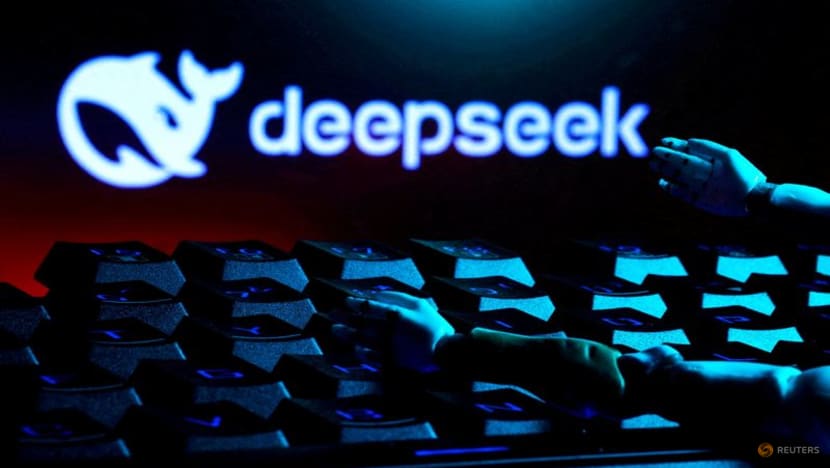Commentary: How DeepSeek may affect Malaysia’s data centre play
Malaysia’s bet on artificial intelligence-driven infrastructure will soon be put to the test, says analyst James Chai.

The DeepSeek logo, a keyboard, and robot hands are seen in this illustration taken on Jan 27, 2025. (File photo: Reuters/Illustration/Dado Ruvic)

This audio is generated by an AI tool.
KUALA LUMPUR: Only history will know if Jan 27, 2025, was a turning point for artificial intelligence (AI) or just a blip.
On that day, United States chipmaker Nvidia, whose semiconductors power the AI industry, lost a staggering US$600 billion in market value - the largest single-day drop in US stock market history – sparking a US$1 trillion rout in tech stocks.
The trigger was a 150-person startup from Hangzhou that few outside China had heard of before that day: DeepSeek.
Generally, a large language model (LLM) company aims to do two things: Train its model on large amounts of internet data (“pre-training”), and then train the model to generate a consistent and useful series of thoughts (“reinforcement learning”).
Seemingly overnight, DeepSeek disrupted the AI landscape with a model that rivals the best American models – but at a fraction of the cost. For the pre-training part, DeepSeek claimed to have completed it in just two months, spending less than US$6 million.
Its claim raises a fundamental question: Are we entering a new AI paradigm where the cost is significantly lower than initially estimated? This has vast implications, including the building of data centres, microchips, energy grids and other investments.
A BOOMING DATA CENTRE INDUSTRY NOW IN QUESTION
For Southeast Asia, the potential twin implications relate to demand and supply. If DeepSeek is truly a state-of-the-art model with vastly lower cost, it would encourage wider adoption of technology. That has been how the region has benefited from low-cost Chinese technology and products in the past.
However, the more interesting question relates to supply - data centres - that has prompted vast foreign direct investments from branded tech companies.
Almost every major Southeast Asian economy has benefited from this, but none more than Malaysia, which is projected to be the third-largest player in Asia in terms of capacity.
Over the past year or so, Malaysia has attracted billions in foreign investment from the likes of NTT, Nvidia, Bridge, AirTrunk, Google and AWS, mainly in Kuala Lumpur and Johor. These investments are driven by Malaysia’s infrastructure advantages: Ample land, low industrial tariffs and construction costs, extensive submarine cable networks, and one of the least water-stressed environments in Asia.
Its capacity of roughly 3 gigawatts (planned and actual) puts it ahead of others, with the data centre market estimated to grow nearly 20 per cent to a US$4 billion by 2029.
Prime Minister Anwar Ibrahim is banking on the digital economy to propel Malaysia’s growth, making AI a priority for his administration. In December, he announced the launch of the National AI Office, forecasting that AI-driven digitalisation could contribute up to 25.5 per cent of Malaysia’s gross domestic product next year “if the speed and rapidity continues like this”.
Of course, this is only achievable if these foreign companies continue to spend billions of dollars on AI, in putting up concrete, buying microchips, setting up server racks and connecting them online.
If the previous rush to build was because demand outpaced supply, DeepSeek now makes us question whether we have built too much and might not need as much infrastructure. Similar to other innovations before, when cloud storage became significantly cheaper, physical bulky servers were rendered less useful.
THE GREAT CATCH-UP
However, there are reasons to believe that this is not one of those instances, and it could be equally true that the opposite might happen.
First, our understanding of DeepSeek might be incomplete. The published cost of US$6 million was only for pre-training and not the overall R&D cost. Though US$6 million is still lower than the pre-training of US counterparts, this difference is in the millions rather than in the billions as claimed.
Similarly, analysts who track export controls have speculated that DeepSeek had access to tens of thousands of frontier Nvidia chips, though not all at the highest specs. Analysts at Semianalysis estimated that DeepSeek’s hardware spend is “well higher than US$500 million over the company history”. What this means is that the overall R&D costs - and the infrastructure and chips required - has not drastically declined.
Second, even with DeepSeek’s cost efficiency gains, it might not erode infrastructure investments. Dario Amodei, CEO of one of the frontier LLM companies, Anthropic, argues that the notion of “first something is expensive, then it gets cheaper” does not apply to AI.
He stated that in the past, when costs go down due to innovation (or when the “scaling curve shifts”, in technical terms), companies end up spending more, rather than less on training models. The reasoning is that the value of higher-performance AI far outweighs any cost savings, so companies reinvest those savings into more advanced AI development, rather than cut infrastructure investments.
Third, greater efficiency could increase demand. DeepSeek’s efficiency could unlock a lower barrier to entry for many companies, either to build or use applications with the model. This is highly dependent on how successful the model, and its smaller variants, are embedded in other everyday devices, and how much this is used by consumers.
What DeepSeek does is to create an incentive and opportunity. It took the lead from Alibaba as the best AI model in 2024, and has now closed the gap with OpenAI in the frontier AI model race. This so-called “great catch-up” is only the beginning. Either way, Malaysia’s bet on AI-driven infrastructure will soon be put to the test.
James Chai is a political analyst, columnist and the author of Sang Kancil (Penguin Random House).


















